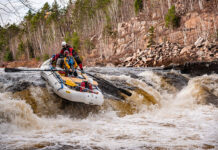I write this stuck in Wyoming’s Grand Teton National Park—not a bad place to be—but the park is closed, the place is deserted. The river I came here to run is now out of bounds; one of the most famous, historic and flat rivers most paddlers have never heard of.
Here for a risk management conference at a private lodge, we are victim to the U.S. government’s Obamacare shutdown and budgetary deadlock. We’re carrying on with our conference, but the park’s gates are locked. We can leave but we can’t get back in if we do.
Famed landscape photographer Ansel Adams’ black and white The Tetons and the Snake River (1942) seared the jagged skyline of the Teton Range into the American psyche, making them what most Americans picture when they think of mountain peaks. Snow capped, ominous and rising from the western plains, the iconic mountains have served as the center of American mountaineering for over a hundred years.
Adams’ famous photo used the upper reaches of the Snake River to contrast against the triangular peaks: the river’s sinuous curve draws the eye from the foreground, down the bank and up the jagged peaks into the sky above. When I first saw the photo on a Christmas gift coffee table book, the image of the Snake drew me in, left me longing to be pulled down the humble river beneath those peaks. And now I sit here, struck by the reality that the river is beyond my reach, its access controlled by the government’s whim.
Rows and rows of sad-looking rafts and dories sit on trailers on the parking lot of Jackson Lake Lodge, where I’m locked up. They, too, are imprisoned, leaving one of the busiest scenic float rivers in the world deserted like the rest of the park. River guides either mill about with nothing to do or have called it a season and moved on. The same Snake that downstream passes through whitewater Ho-
back and Hell’s canyons, up this high is just flat and swift, dwarfed and humbled by the Tetons. The Snake is often overlooked by seri- ous whitewater paddlers, but is magnificent in views and important in our history.
Grand Teton National Park is one of the birthplaces of commercial rafting and the Snake continues to put any other commercial rafting river to shame—upwards of 200,000 tourists float this section every year.

THE TETONS FAMED HISTORY
The famous and extremely wealthy John D. Rockefeller Jr. was an avid outdoorsman and visited the Tetons in the 1920s. Rockefeller secretly began buying up land with the intention of handing it all over to the government as a gift.
Political and legal wrangling got in the way, and it was not until 1950—more than 20 years later—that his donated land gained of- ficial park status.
Rockefeller promptly set about building Jackson Lake Lodge and hired horse wranglers to take clients down the Snake in WWII surplus inflatable bridge pontoons with sweep oars.
That was the start of commercial rafting in this watershed. Further to the south in Utah and Arizona, Bus Hatch and Norman Nevills were pioneering commercial whitewater on the Green and Colorado, but for Rockefeller, the river was about scenery. He wanted people to float through Adams’ photo, and revel in the spectacle of the mountains looming overhead. When whitewater daredevils were gaining media attention in the mid-60s, a half dozen river operators sprung up and still operate on the Snake, capturing the road traffic through the Tetons and nearby Yellowstone National Park.
As the creator of the commercial float trip, Rockefeller waited out decades of government delay to ensure this land would spread the love of rivers to the masses. Like Rockefeller and so many others, I was drawn to this river, but here I sit, my access denied, looking at a real-life image of the Tetons and the Snake River, and a snapshot it will remain.



 This article was first published in the Spring 2014 issue of Rapid Magazine.
This article was first published in the Spring 2014 issue of Rapid Magazine. 




